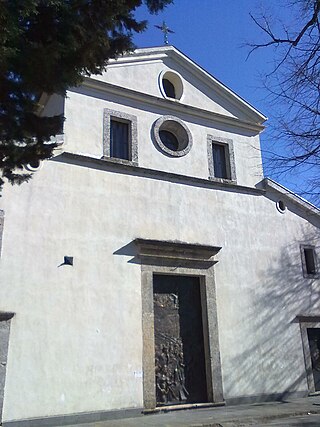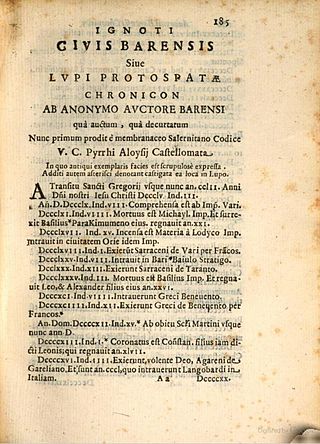
A chronicle is a historical account of events arranged in chronological order, as in a timeline. Typically, equal weight is given for historically important events and local events, the purpose being the recording of events that occurred, seen from the perspective of the chronicler. A chronicle which traces world history is a universal chronicle. This is in contrast to a narrative or history, in which an author chooses events to interpret and analyze and excludes those the author does not consider important or relevant.
Chronicon Paschale, also called Chronicum Alexandrinum, Constantinopolitanum or Fasti Siculi, is the conventional name of a 7th-century Greek Christian chronicle of the world. Its name comes from its system of chronology based on the Christian paschal cycle; its Greek author named it Epitome of the ages from Adam the first man to the 17th year of the reign of the most August Heraclius.
In historiography, a chronicon is a type of chronicle or annals. Examples are:
Marcellinus Comes was a Latin chronicler of the Eastern Roman Empire. An Illyrian by birth, he spent most of his life at the court of Constantinople. His only surviving work, the Chronicle, focuses on the Eastern Roman Empire.

Acerno is a town and comune in the province of Salerno in the region of Campania in south-western Italy.

Albert of Stade was a German monk, historian and poet.
Landulf I, called the Old, was the first gastald of Capua of his illustrious family, which would rule Capua until 1058. According to the Cronaca della dinastia di Capua, he ruled in Old Capua for twenty five years and four months and in New Capua for another year and eight months. According to Erchempert, he was "a very bellicose man".
Romuald Guarna was the Archbishop of Salerno from 1153 to his death. He is remembered primarily for his Chronicon sive Annales, an important historical record of his time.
Sico II was the second prince of Salerno. Son and successor of Siconulf, he ruled the Principality of Salerno from his father's death in 851 to his own deposition in 853. He is given the ordinal "II" because he was the second Sico to rule in southern Italy, the previous Sico being prince of Benevento.

The Principality of Salerno was a medieval Southern Italian state, formed in 851 out of the Principality of Benevento after a decade-long civil war. It was centred on the port city of Salerno. Although it owed allegiance at its foundation to the Carolingian emperor, it was de facto independent throughout its history and alternated its allegiance between the Carolingians and their successors in the West and the Byzantine emperors in the east.
Mastalus I was the penultimate patricius of Amalfi. He was succeeded by his son, Mastalus II, who was raised to the status of dux. His own father was the last prefect, Manso I.
Helinand of Froidmont was a medieval poet, chronicler, and ecclesiastical writer.
Victor of Tunnuna was Bishop of the North African town of Tunnuna and a chronicler from Late antiquity. He was also considered a martyr by Isidore of Seville.
The Emirate of Bari was a short-lived Islamic state in Apulia, in what is now Italy, ruled by non-Arabs, probably Berbers and Black Africans. Controlled from the South Italian city of Bari, it was established about 847 when the region was taken from the Byzantine Empire, but fell in 871 to the army of the Carolingian emperor Louis II.

The Archdiocese of Salerno-Campagna-Acerno is a Latin Church diocese of the Catholic Church in Campania, southern Italy, created in 1986. The historic Archdiocese of Salerno was in existence from the tenth century, having been elevated from a sixth-century diocese. The Diocese of Acerno was combined with the archdiocese in 1818.

Li coronemenz Looïs is an anonymous twelfth-century Old French chanson de geste. It is sometimes attributed to Bertrand de Bar-sur-Aube and dated 1137. The first modern critical edition of the text was published in 1888 by Ernest Langlois under the title Le Couronnement de Louis.
Landulf of Conza, a Lombard nobleman, was briefly Prince of Benevento in 940 and then briefly Prince of Salerno in 973. The son of Atenulf II of Benevento, Landulf ruled on his father's death (940) as co-prince with his uncle, Landulf I, who soon sent him into exile. He initially took refuge at the court of Marinus II of Naples, from where he sought shelter in Salerno through his sister, Gaitelgrima, the second wife of Prince Guaimar II of Salerno. This he received and he was soon appointed gastald of Conza, while his sons—Landenulf, Landulf, Indulf, and Guaimar—were invested with land in Salerno. The Chronicon Salernitanum, which is the most important source for Landulf's life, names the counties of Marsi, Sarno, and Lauro as those of Guaimar, Indulf, and Landenulf, respectively, but does not name a county for Landulf.

Anonymi Barensis Chronicon is a medieval Italian annalistic chronicle.

The siege of Salerno was one of the campaigns of the Aghlabids in southern Italy during their conquest of Sicily. The Lombard city of Salerno had strong defences and, despite the use of stone-throwing artillery, the siege lasted a little over a year from its beginning in late 871 or early 872. Prince Guaifer of Salerno led the defence, but the siege was only lifted by the arrival of an army of Lombards and Franks under the Emperor Louis II.
Peter I was the bishop of Benevento from 887 or 894 until at least 902. His pontificate was marked by rapid political shifts, with Benevento successively under Byzantine (891–895), Spoletan (895–897) and Lombard rule. Peter was imprisoned and exiled a first time in 895. He served as the regent and de facto ruler of the Principality of Benevento between 897 and 900. In 902, he was proclaimed prince by the people but refused the office and went into exile a second time. He died in 914, possibly still in exile. He was buried in Benevento






